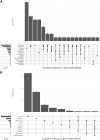Drivers of infection with Toxoplasma gondii genotype type II in Eurasian red squirrels (Sciurus vulgaris)
- PMID: 38263195
- PMCID: PMC10804655
- DOI: 10.1186/s13071-023-06068-6
Drivers of infection with Toxoplasma gondii genotype type II in Eurasian red squirrels (Sciurus vulgaris)
Abstract
Background: In September 2014, there was sudden upsurge in the number of Eurasian red squirrels (Sciurus vulgaris) found dead in the Netherlands. High infection levels with the parasite Toxoplasma gondii were demonstrated, but it was unclear what had caused this increase in cases of fatal toxoplasmosis. In the present study, we aimed to gain more knowledge on the pathology and prevalence of T. gondii infections in Eurasian red squirrels in the Netherlands, on the T. gondii genotypes present, and on the determinants of the spatiotemporal variability in these T. gondii infections. The presence of the closely related parasite Hammondia hammondi was also determined.
Methods: Eurasian red squirrels that were found dead in the wild or that had died in wildlife rescue centres in the Netherlands over a period of seven years (2014-2020) were examined. Quantitative real-time polymerase chain reaction was conducted to analyse tissue samples for the presence of T. gondii and H. hammondi DNA. Toxoplasma gondii-positive samples were subjected to microsatellite typing and cluster analysis. A mixed logistic regression was used to identify climatic and other environmental predictors of T. gondii infection in the squirrels.
Results: A total of 178 squirrels were examined (49/178 T. gondii positive, 5/178 H. hammondi positive). Inflammation of multiple organs was the cause of death in 29 squirrels, of which 24 were also T. gondii polymerase chain reaction positive. Toxoplasma gondii infection was positively associated with pneumonia and hepatitis. Microsatellite typing revealed only T. gondii type II alleles. Toxoplasma gondii infection rates showed a positive correlation with the number of days of heavy rainfall in the previous 12 months. Conversely, they showed a negative association with the number of hot days within the 2-week period preceding the sampling date, as well as with the percentage of deciduous forest cover at the sampling site.
Conclusions: Toxoplasma gondii infection in the squirrels appeared to pose a significant risk of acute mortality. The T. gondii genotype detected in this study is commonly found across Europe. The reasons for the unusually high infection rates and severe symptoms of these squirrels from the Netherlands remain unclear. The prevalence of T. gondii in the deceased squirrels was linked to specific environmental factors. However, whether the increase in the number of dead squirrels indicated a higher environmental contamination with T. gondii oocysts has yet to be established.
Keywords: Microsatellite typing; Monitoring; Oocyst; Parasite; Population structure; Sentinel; Squirrel; Toxoplasmosis; Zoonoses.
© 2024. The Author(s).
Conflict of interest statement
The authors declare that they have no competing interests. This is an original research article that is not under review for publication in another journal.
Figures




Similar articles
-
Acute fatal toxoplasmosis in three Eurasian red squirrels (Sciurus vulgaris) caused by genotype II of Toxoplasma gondii.J Wildl Dis. 2012 Apr;48(2):454-7. doi: 10.7589/0090-3558-48.2.454. J Wildl Dis. 2012. PMID: 22493121
-
Survey of Toxoplasma gondii in Urban and Rural Squirrels (Sciuridae) in Manitoba, Canada.J Wildl Dis. 2023 Jan 1;59(1):149-154. doi: 10.7589/JWD-D-21-00171. J Wildl Dis. 2023. PMID: 36763340
-
Seasonality in the proportions of domestic cats shedding Toxoplasma gondii or Hammondia hammondi oocysts is associated with climatic factors.Int J Parasitol. 2016 Apr;46(4):263-73. doi: 10.1016/j.ijpara.2015.12.006. Epub 2016 Jan 25. Int J Parasitol. 2016. PMID: 26820303
-
Transmission of Toxoplasma: clues from the study of sea otters as sentinels of Toxoplasma gondii flow into the marine environment.Int J Parasitol. 2005 Oct;35(11-12):1155-68. doi: 10.1016/j.ijpara.2005.07.002. Int J Parasitol. 2005. PMID: 16157341 Review.
-
Geographical distribution of Toxoplasma gondii genotypes in Asia: A link with neighboring continents.Infect Genet Evol. 2017 Sep;53:227-238. doi: 10.1016/j.meegid.2017.06.002. Epub 2017 Jun 3. Infect Genet Evol. 2017. PMID: 28583867 Review.
References
MeSH terms
Grants and funding
LinkOut - more resources
Full Text Sources
Medical

